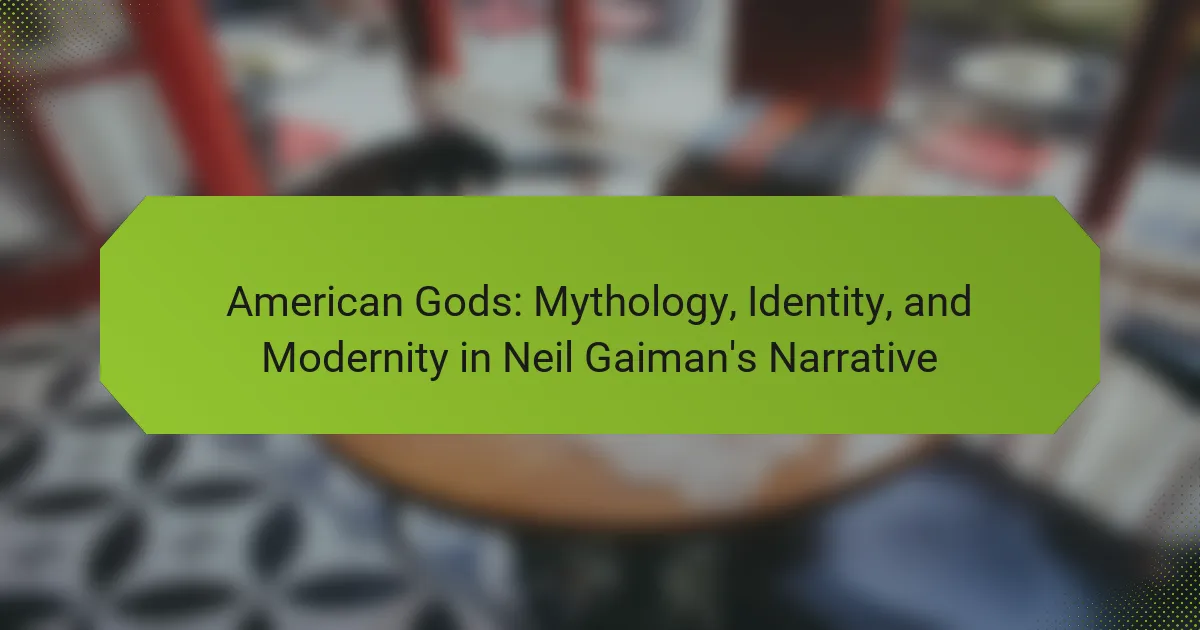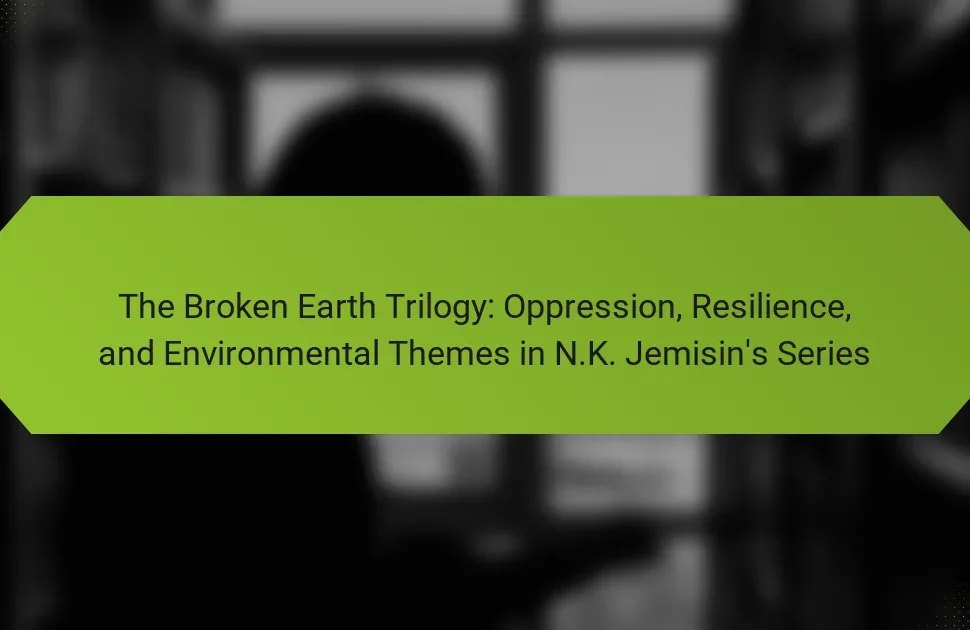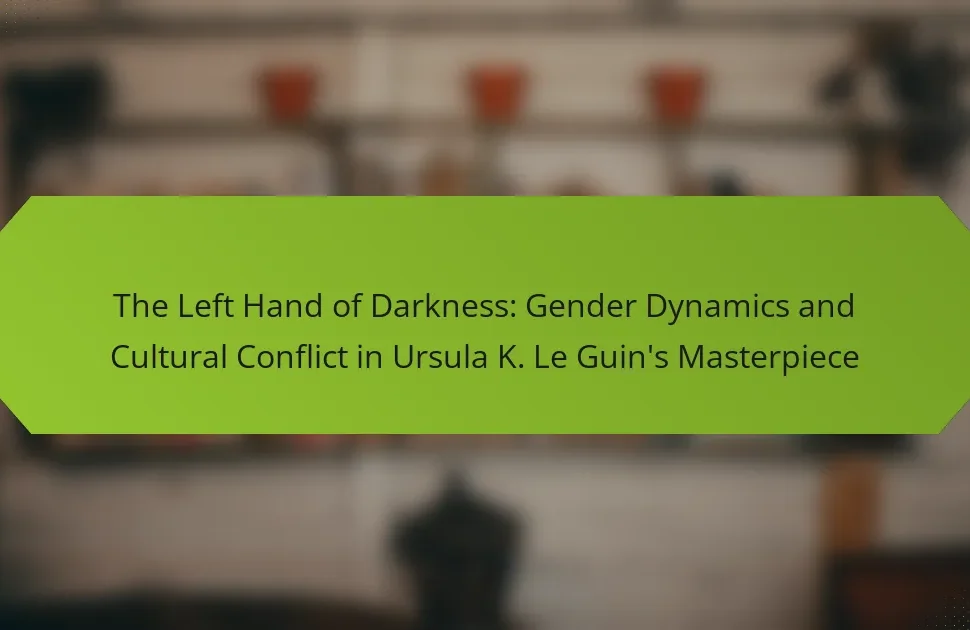In a rapidly changing world, how do ancient myths shape modern identity? Neil Gaiman’s “American Gods” intertwines mythology with contemporary culture, exploring the clash between old and new gods. The narrative highlights character struggles, cultural conflicts, and the impact of modernization on belief systems. Through diverse mythological figures, Gaiman critiques consumerism and emphasizes the fluidity of identity in today’s society.
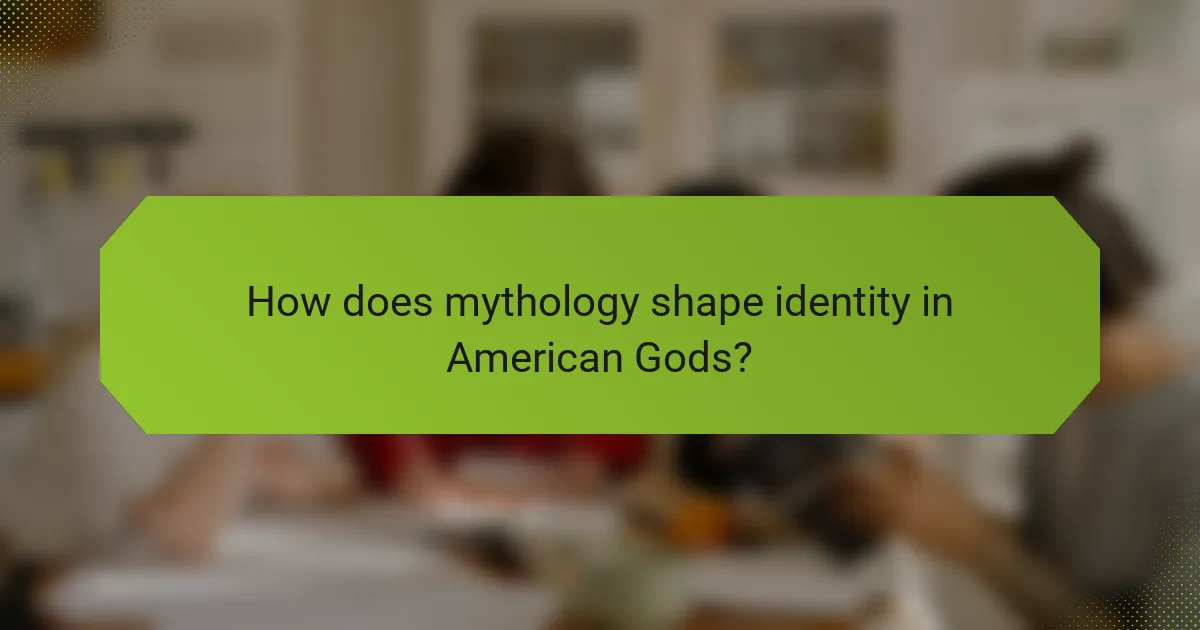
How does mythology shape identity in American Gods?
Mythology shapes identity in “American Gods” by intertwining ancient beliefs with modern culture. The characters embody various mythological figures, reflecting how these narratives influence personal and collective identities. Gaiman explores the tension between old gods and new, illustrating the struggle for relevance in a changing society. This dynamic highlights the evolving nature of identity, rooted in historical myths yet adapted to contemporary contexts. Ultimately, the narrative emphasizes that identity is a fluid construct shaped by both heritage and modernity.
What role do ancient deities play in modern society?
Ancient deities influence modern society by shaping cultural identity and belief systems. In Neil Gaiman’s “American Gods,” these deities symbolize the clash between traditional beliefs and contemporary life. They reflect how mythology adapts to modernity, illustrating the persistence of ancient narratives in today’s world. As a result, characters embody the struggle for relevance in a society increasingly dominated by technology and consumerism. This narrative highlights the unique attribute of mythology’s adaptability, showcasing its role in maintaining cultural connections amidst change.
How do cultural backgrounds influence character development?
Cultural backgrounds significantly shape character development in “American Gods.” They influence identity, beliefs, and motivations, creating a rich narrative tapestry. Characters embody diverse mythologies, reflecting their origins and experiences. For instance, the clash between old gods and new gods symbolizes cultural transitions. Gaiman’s exploration of identity highlights how cultural heritage informs personal journeys and conflicts. This interplay adds depth and complexity to character arcs, illustrating the broader theme of modernity versus tradition.

In what ways does Neil Gaiman explore the clash between old and new gods?
Neil Gaiman explores the clash between old and new gods through character interactions and thematic contrasts. The narrative illustrates how ancient deities struggle for relevance in a modern world dominated by technology and consumerism. Gaiman uses Shadow Moon’s journey to highlight identity conflicts, as he navigates between loyalty to traditional beliefs and the allure of contemporary culture. The tension between the gods reflects broader societal changes, emphasizing the ongoing battle for belief and significance in an evolving landscape. This dynamic showcases the unique attribute of Gaiman’s work: merging mythology with modernity to provoke thought on faith and identity.
Which themes illustrate the tension between tradition and modernity?
American Gods illustrates the tension between tradition and modernity through its characters and narratives. The old gods represent traditional beliefs and cultural identities, while the new gods embody modernity and technological advancements. This conflict highlights the struggle for relevance in a changing world, showcasing how ancient myths adapt or fade in contemporary society. Themes such as cultural assimilation, the quest for identity, and the impact of consumerism further emphasize this dichotomy, reflecting the broader societal shifts between honoring heritage and embracing progress.
How do characters embody different aspects of American culture?
Characters in “American Gods” embody various aspects of American culture by representing diverse beliefs, identities, and societal changes. For instance, the old gods symbolize traditional values and mythologies, while new gods reflect modern obsessions like technology and media. This contrast highlights the evolving nature of identity in America, showcasing how cultural narratives shift over time. The characters’ interactions illustrate the struggle between preserving heritage and adapting to contemporary influences, emphasizing the complexity of American identity. Gaiman’s narrative effectively captures the tension between the past and present, revealing how mythology informs modern life.

What are the key narrative techniques used in American Gods?
American Gods employs various narrative techniques that intertwine mythology, identity, and modernity. Key techniques include the use of multiple perspectives, non-linear storytelling, and rich symbolism. These elements enhance the exploration of cultural clashes and the evolution of gods in contemporary society. The narrative’s fragmented structure mirrors the disconnection of modern identity, while interwoven myths create a tapestry that reflects the complexity of belief systems. Gaiman’s use of dialogue and character development further deepens the reader’s engagement with the themes of transformation and adaptation.
How does Gaiman utilize symbolism to convey deeper meanings?
Gaiman employs symbolism in “American Gods” to explore themes of mythology, identity, and modernity. He uses diverse symbols, such as the characters representing old gods, to convey the struggle between tradition and contemporary society. For instance, the character Mr. Wednesday symbolizes the fading power of myth in a modern world dominated by technology and consumerism. This juxtaposition highlights the loss of cultural identity and the search for meaning in a rapidly changing landscape. Additionally, Gaiman’s use of settings, like Shadow’s journey across America, symbolizes the quest for self-discovery amidst societal transformation. These symbols deepen the narrative, inviting readers to reflect on their own identities in relation to cultural heritage.
What role does storytelling play within the plot?
Storytelling is central to the plot of “American Gods,” as it weaves together mythology, identity, and modernity. The narrative employs diverse tales to explore the clash between old gods and new, reflecting contemporary societal issues. Through character arcs and intertwining stories, Gaiman illustrates how personal and collective identities are shaped by myth. This multifaceted storytelling enhances thematic depth, inviting readers to engage with the complexities of belief and cultural transformation.
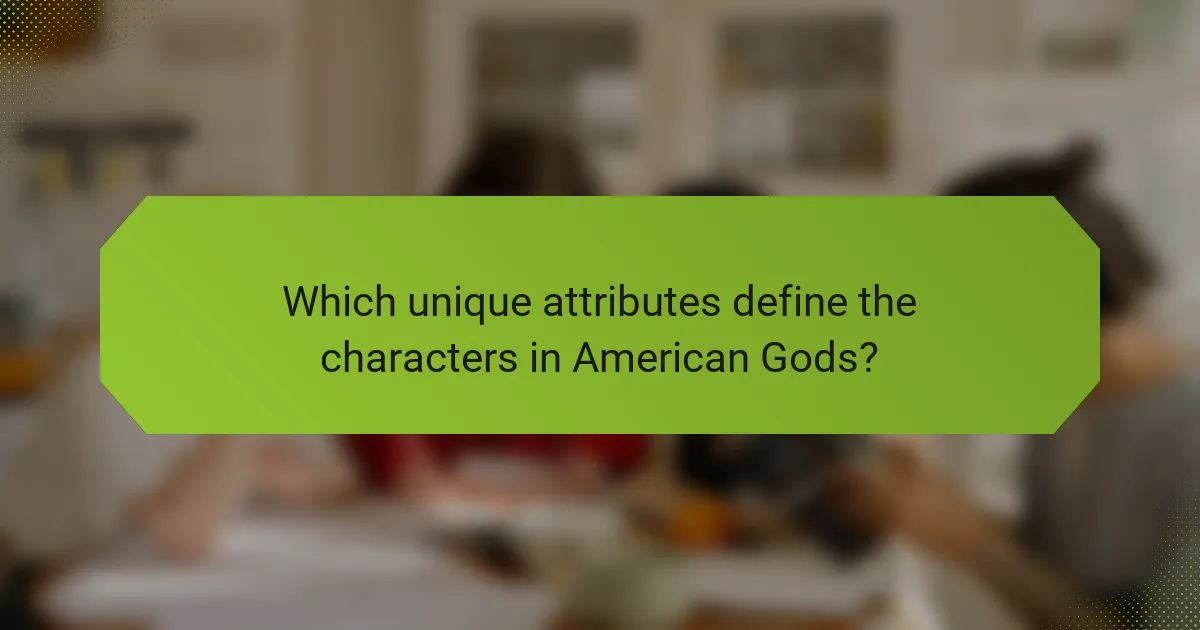
Which unique attributes define the characters in American Gods?
The unique attributes defining characters in American Gods include their mythological origins, cultural significance, and personal struggles. Each character embodies distinct traits that reflect their respective mythologies. For instance, Mr. Wednesday represents wisdom and cunning, while Shadow Moon symbolizes resilience and transformation. These attributes contribute to the narrative’s exploration of identity and modernity. Furthermore, characters like Czernobog exhibit rare traits, such as their ties to Slavic folklore, highlighting the diversity of mythological influences within the story.
How do individual backstories contribute to the overall narrative?
Individual backstories enrich the overall narrative by adding depth and complexity to character development. In “American Gods,” each character’s history reflects themes of mythology, identity, and modernity. These backstories reveal how personal experiences shape their beliefs and motivations, enhancing the interplay between ancient deities and contemporary society. For instance, Shadow Moon’s journey illustrates the struggle between faith and doubt, embodying the broader conflict between old and new. This intricate layering of narratives allows readers to grasp the multifaceted nature of identity in a modern context.
What differentiates the portrayal of gods from humans in the story?
The portrayal of gods in “American Gods” emphasizes their otherworldly powers and eternal nature, contrasting with the human experience of mortality and identity struggles. Gods embody mythological significance, while humans navigate modernity and personal crises. This distinction highlights the unique attributes of divine beings, such as their ability to shape reality, compared to humans’ limited agency. The narrative explores how these portrayals reflect cultural shifts, illustrating the rare attribute of gods’ fading relevance in a contemporary society focused on technology and individualism.
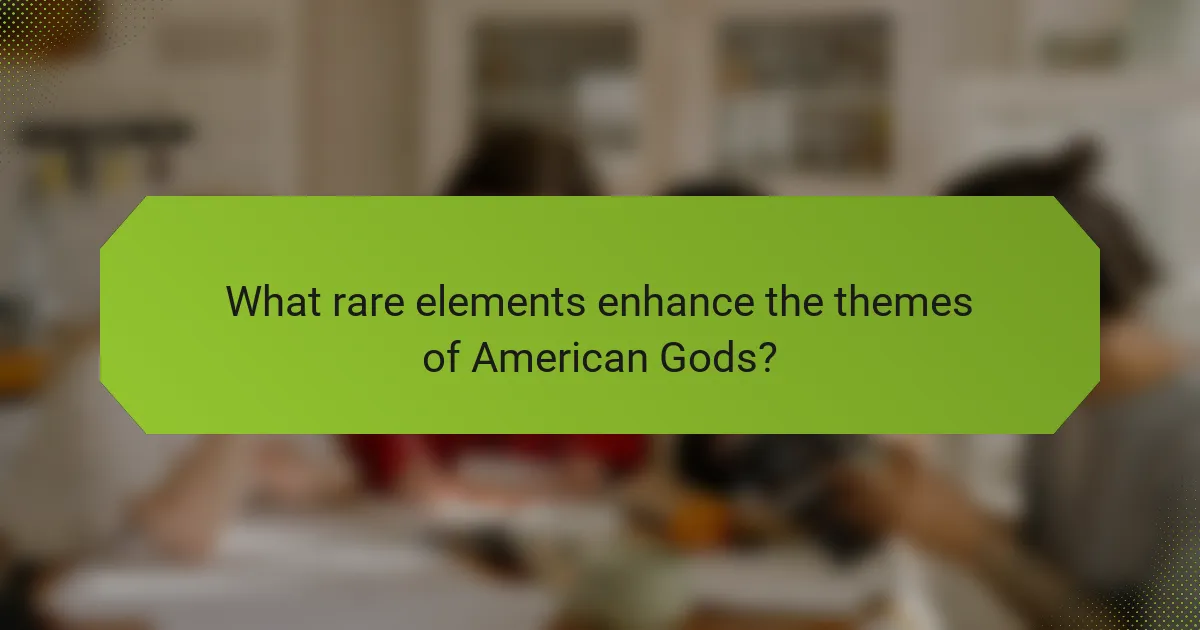
What rare elements enhance the themes of American Gods?
Rare elements that enhance the themes of American Gods include the use of lesser-known deities and mythological figures. These characters symbolize the clash between traditional beliefs and modern identity. For instance, the inclusion of Slavic and African gods adds depth to the narrative, showcasing cultural diversity. The unique portrayal of these entities highlights their struggles for relevance in contemporary society. Additionally, the rare attribute of syncretism illustrates how different cultures blend their myths, enriching the story’s exploration of identity and belief systems.
How does the use of folklore influence the narrative structure?
Folklore significantly influences the narrative structure of “American Gods” by intertwining mythological elements with contemporary themes. This integration creates a dual-layered storytelling approach that reflects the clash between old and new identities. Gaiman’s use of folklore allows characters to embody various mythological attributes, enriching their identities and motivations. The narrative shifts between past and present, showcasing how ancient beliefs shape modern experiences. This unique attribute of blending folklore with modernity deepens the reader’s engagement with the characters and themes.
What significance do lesser-known mythological figures hold in the story?
Lesser-known mythological figures in “American Gods” enrich the narrative by representing diverse cultural identities. They illustrate the theme of forgotten traditions and the struggle for relevance in modern society. These figures, such as Anansi and Czernobog, highlight the clash between old and new gods, emphasizing the importance of memory and belief. Their unique attributes provide depth to the story, showcasing how marginalized voices contribute to the broader tapestry of mythology and identity.
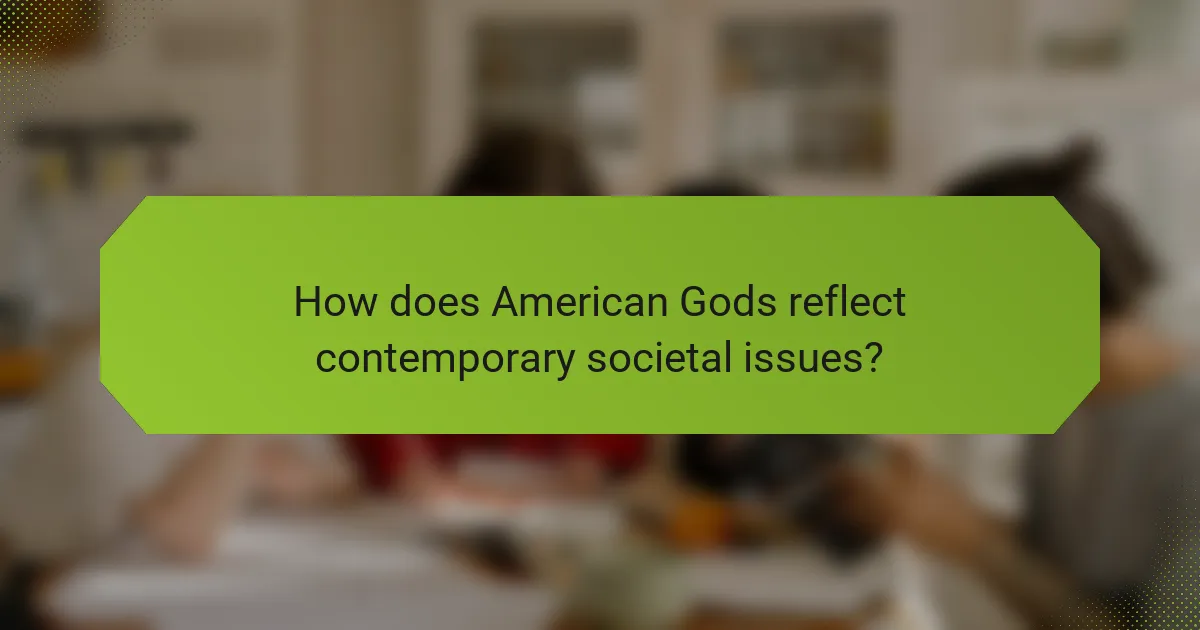
How does American Gods reflect contemporary societal issues?
American Gods reflects contemporary societal issues by exploring themes of identity, cultural conflict, and the impact of modernization on belief systems. The narrative illustrates how ancient mythologies clash with modern values, highlighting the struggle for relevance in a rapidly changing world. Characters embody various aspects of societal change, representing the tension between tradition and progress. As a result, the story serves as a mirror to current societal dynamics, emphasizing the need for connection and understanding in a diverse landscape.
Which modern dilemmas are mirrored through the narrative?
The narrative of “American Gods” mirrors modern dilemmas such as cultural identity, religious conflict, and the impact of technology on belief systems. Gaiman explores how traditional deities struggle for relevance in a world dominated by consumerism and modern values. The characters embody the tension between old and new, highlighting the quest for meaning in a rapidly changing society. These themes resonate with contemporary issues, reflecting society’s ongoing search for identity amid globalization and technological advancement.
How do the characters address themes of immigration and identity?
Characters in “American Gods” explore themes of immigration and identity through their diverse backgrounds and experiences. They embody the struggles of adapting to a new culture while maintaining their heritage. For instance, Shadow Moon’s journey reflects the search for personal identity amidst a landscape of competing mythologies and beliefs. The presence of gods from various cultures highlights the complexities of identity formation in a multicultural society. Additionally, the narrative illustrates how immigration shapes one’s sense of belonging and connection to both old and new worlds. This interplay of mythology and modernity underscores the ongoing negotiation of identity in the face of change.
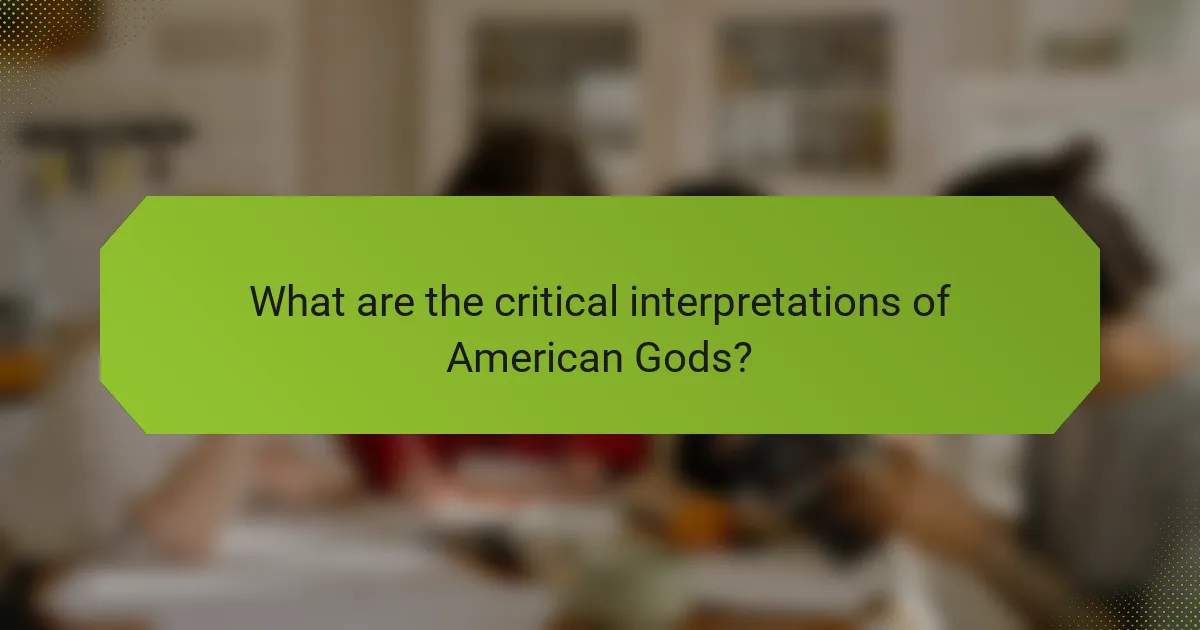
What are the critical interpretations of American Gods?
Critical interpretations of “American Gods” explore themes of mythology, identity, and modernity. The narrative juxtaposes ancient gods with contemporary society, highlighting cultural displacement. Gaiman critiques consumerism, suggesting that belief shapes reality. Unique interpretations focus on the fluidity of identity, reflecting the immigrant experience. The tension between old and new gods symbolizes the struggle for relevance in a changing world.
How do various literary critiques assess Gaiman’s narrative choices?
Literary critiques assess Gaiman’s narrative choices in “American Gods” through themes of mythology, identity, and modernity. Critics highlight his unique blending of traditional myth with contemporary issues, showcasing characters that embody cultural identities. This approach allows Gaiman to explore the impact of modernity on ancient beliefs, revealing how myths adapt and evolve. Additionally, the narrative structure, which intertwines multiple perspectives and timelines, is praised for its complexity and depth, enhancing the reader’s engagement with the text. Critics emphasize that Gaiman’s stylistic choices, including rich imagery and dialogue, contribute significantly to the novel’s thematic resonance.
What insights do scholars provide regarding the cultural impact of the story?
Scholars highlight that “American Gods” explores the intersection of mythology and identity in contemporary society. The narrative illustrates how ancient myths adapt to modernity, reflecting cultural shifts. Gaiman’s work emphasizes the struggle between old gods and new beliefs, symbolizing the search for identity in a rapidly changing world. This dynamic fosters discussions about cultural heritage, globalization, and the relevance of mythology today. The integration of diverse mythologies showcases the richness of cultural narratives, reinforcing the importance of storytelling in shaping identity.
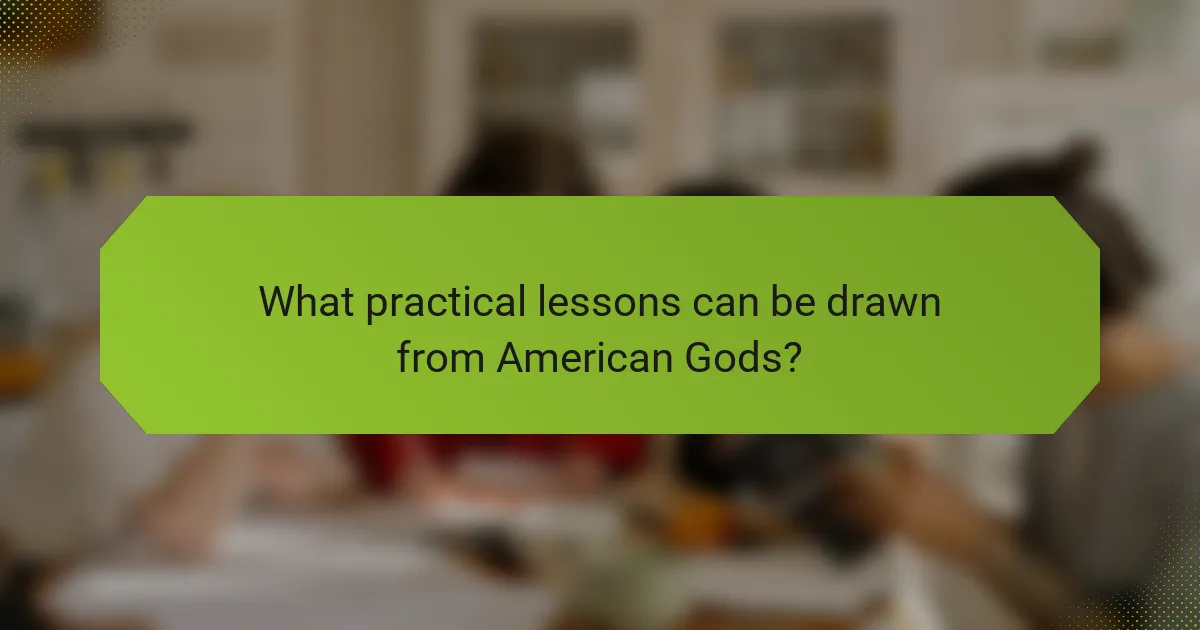
What practical lessons can be drawn from American Gods?
American Gods teaches valuable lessons about the clash between traditional beliefs and modern identity. The narrative highlights the importance of understanding one’s roots while adapting to contemporary society. It emphasizes the need to acknowledge diverse cultures and mythologies in shaping personal and collective identities. Additionally, the story illustrates how the struggle for relevance affects both individuals and communities, reflecting broader societal changes.
Which themes can inspire personal reflection and growth?
American Gods explores themes of mythology, identity, and modernity, inspiring personal reflection and growth. The clash between old and new gods prompts readers to examine their beliefs and values. Identity is shaped by cultural narratives, urging introspection on personal heritage. Modernity’s impact on spirituality encourages exploration of personal connections to tradition. The complex relationships among characters illustrate the importance of community in personal development.
What strategies can readers apply to engage with complex narratives?
Readers can engage with complex narratives like “American Gods” by employing analytical strategies. They should identify key themes, such as mythology and identity, and explore character motivations. Analyzing the interplay between the old gods and modernity reveals deeper meanings. Additionally, readers can contextualize the narrative within contemporary society, enhancing their understanding. Engaging with secondary sources, like literary critiques, can provide further insights into Gaiman’s narrative techniques and thematic depth.
